#software for venue management
Explore tagged Tumblr posts
Text
Solving Arcade Payment Challenges: The Shift from Tokens to Tap-to-Play
The transition from tokens to tap-to-play solutions in arcades is addressing long-standing challenges like lost coins and operational inefficiencies.
By moving to swipe cards and RFID systems, arcades can now offer a faster, smoother experience for players while streamlining internal management. This shift also enhances data tracking, giving arcade operators valuable insights into customer preferences and spending patterns.
With the introduction of contactless payments, arcades can reduce cash handling risks and improve security, ensuring both players and businesses benefit from these modern advancements. The evolution of arcade payment systems is shaping a more efficient and enjoyable future for indoor gaming.
0 notes
Text
Introducing HeadBox 3D Studio: The Future of Immersive Events - Interview With the CEO
HeadBox, Australia’s leading digital meetings and events platform, is raising the bar with its latest innovation—HeadBox 3D Studio. This state-of-the-art software promises to transform how venues and events teams create and share proposals, offering a unique, personalised experience through interactive 3D tours embedded with AI-generated narrator videos. A New Era for Venues and Hotels For the…
#3D Studio#AI#AI narration#AI technology#AI tools#AI-driven#digital#digital proposals#Eco-Friendly#event management#event planning#event solutions#event tech#event venues#events#global clients#guided tours#HeadBox#HeadBox platform#hospitality#hospitality tools#hotel tours#hotels#immersive#immersive experience#innovation#international clients#language barriers#meeting software#meeting tools
0 notes
Text
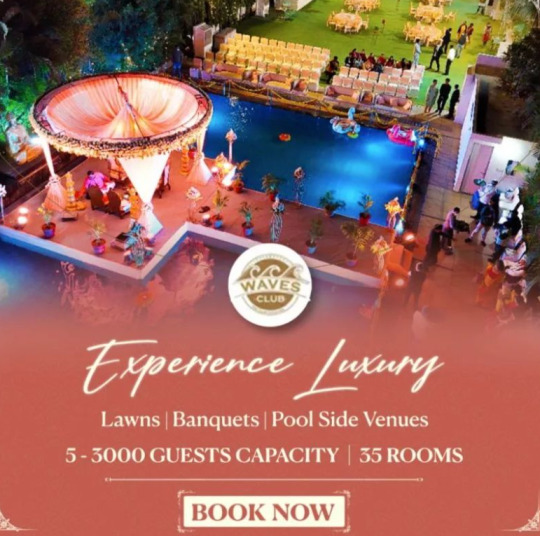
India's Best Banquet Management Software | Wedding Venue Software.
Optimize Banquet Management with House of Banquet – India's best Banquet Management Software. Elevate weddings seamlessly with our advanced Wedding Venue Software.
0 notes
Text
Events and meetings Services | Contact Us today | Tripkartz
Corporate Meetings Planning and Exceptional Meeting Venues | TripKartz
Unlock success with TripKartz’s dedicated corporate meeting planning and outstanding meeting venues. Elevate your events and meetings with our expert solutions.
Meetings — A venue for every occasion
Despite the setting or the number of participants, what makes a meeting successful is the coordination and professional execution. We will apply our experience and sourcing network in India across cities or for any global destination with ease.
We focus on the details to fulfill your objectives
Board meetings
Trainings
Press and Media Meets
Buyer meetings
Review Meets
Recruitment Drives
Incentives — Make Business a delight
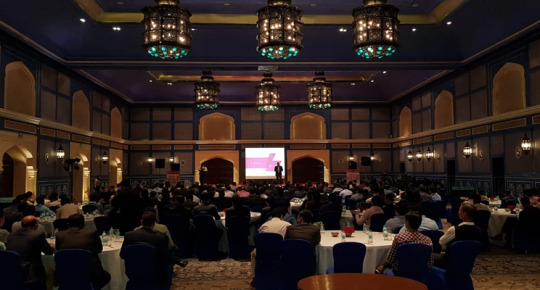
Our experts will add elements of fun, reward and surprise
Sales recognition
Client loyalty program
Team Engagement
Performance Reward
Events — Creatively customized
Whether it is an exotic destination or not, our team will ensure that we make the event memorable and unique. We work closely with Domestic and international convention spaces and offbeat venues to ensure that every event is unique , creative and executed successfully.
We emphasis on where it is needed ie your customers and products.
Product launches
Award ceremonies
Cocktail Events
Annual and Festive events
Registered Office
2nd floor, Day Star Building, 10th cross Pampa Ext, Kempapura, Hebbal, Bangalore — 560024 Karnataka, India Tel No — +91 9591775553/ +91 9513921785
#business hotels#Keyword#corporate travel management companies in bangalore#travel management companies in bangalore#corporate meetings#Business events#events and meetings#"corporate travel agents#event venues#meeting venues#meetings and events planning#conference management#extended stay hotels#corporate meetings planning#business transportation#corporate events#corporate event management company#corporate travel management#corporate events and meetings#conference management software#corporate transportation#business car rentals#corporate travel agents#corporate hotels#conference venues
0 notes
Text
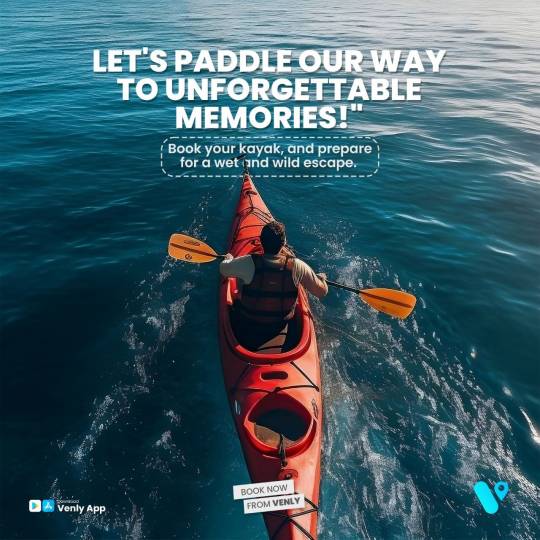
Embark on Your Next Adventure! Book Now and Explore the Uncharted. Book a paddle through the Venly app to relax and enjoy nature's masterpiece. Become an explorer today… Visit our website now : https://venlyapp.com/blog/what-can-i-find-on-venly/
0 notes
Text
:(
#not fandom related#personal log stardate#ive got sm pent up anger rn i just need to fuckling famblr a bit#a coworkert and i wanted to meet up today but they already had plans for today and said we might be able to meet nevertheless#and they'd text me when they get home so i could go to their plac e to meet them#they were busy all day and now its past 8pm. they texted me they're home not tbhj im already settled in for the night and they're#exhausted from the day so i said maybe we can postpone it to next week#which is ok. still im angry bc we basically had agreed on meeting up but they were too busy to actually manage to make the time for me ig#i feel v discouraged now bc. maybe im not that important to them??? but. before making any assum#*assumptions i'll be all grown up and talk abt w them on monday and ask them and tekll them how i feel#in the past i've often avoided conflict in relationships but no longer. i actually rly like them and i want to be their friend and be honest#w them. im just... disappointed sad and a bit angey bc. we agreed on meeting this afternoon and they couldn't manage.#ok. onto the next part. i bought a concert ticket on eventim and only realized later that a local venue also sells tickets. and now im#frothing at the mouth in qnger bc eventim is such a horrible company and i cant give the ticket back and they created an#account forv me even tho i explicetely clicked on 'proceed as a guest' so i wouldnt have to register and now these stupid mfs#ctrated an account for me w/o asking me if i wanted that!!! and i cant even get revenge by giving my ticket back and getting the money back#bc it's not an option. aaarrgghh!! i should've checked beforehand if the tickets are sold anywhere else#i feel so stupid#also i accidentelly deleted#my ofmd episides from my usb drive and now im trying to recover them despite Not being a computer/software person at all :(#i hate everything and i feel so stupiud.#accidentally deleted stuff bought from a stupid ass company w/o doing proper research first got kinda let down by a friend. stupid ass shit#day. still i shouldn't beat myself up. i'll talk to my coworker/friend on monday abt how i feel and abt how we can improve next time we#decide to meet up. i won't buy from eventim ever again and i'll delete my stupid as shit bitch account as soon as i have my ticket#(which is btw more expemsive then the one from the local seller ifhml)#and i will try to not accidentally delete files again. one time i also accidentally shredded an important document which was still needed#the document wasn't mine btw :)#anyway
0 notes
Text
Which Education🎓📚 is right for you?
Mercury rules your interest and consequently which type of course you would select.
Now you have to see how Mercury is placed. For example if Mercury is conjunct Moon it would have same effect as Mercury in Cancer or Moon opposite Mercury.
Mercury -Sun: It is called Budh Aditya yoga. These people can shine in political science, geology, sociology, medicine and they can be good leaders too. They may prepare for competitive exams.
Mercury-Moon: Some changes or confusion in choice of course. Can study more than one subject but both vastly different from each other. Chemical, hotel management, nutrition, chef, psychology, tarot and intuitive studies.
Mercury-Mars: Some obstacles in education, breaks and interruptions (dropping classes), engineering (especially related to machines, drawings, plans, civil, electronics), medicine (especially related to surgery), fire and safety engineering,
Mercury-Venus: Sales, marketing, HR, interior designing, makeup courses, all type of fine arts, vocational courses, acting courses.
Mercury-Saturn: Engineering (like construction , petroleum, mining core subjects), structural engineering, drafting, administrative studies.
Mercury-Jupiter: Finance, CPA, CMA, accounting, teaching, law field, journalism, VJ, pilots, aeronautical.
Mercury- Rahu: Chemical, nuclear subjects, cinematography, software courses, digital marketing, share markets, computer hardware, import export, AI, Machine Learning courses.
Mercury-Ketu: Computer coding, electrical engineering, bio technology, astrology, virology, research oriented fields.
For Readings DM
#astrology#astrology observations#zodiac#zodiac signs#astro community#astro observations#vedic astrology#astro notes#vedic astro notes#astrology community#mercury signs#mercury in aquarius#mercury retrograde#pisces mercury
849 notes
·
View notes
Text

The Best Album Cover Shoots – in pictures
From the Beatles crossing a zebra to a naked Prince, via Grace Jones attempting the anatomically impossible and Led Zeppelin’s New York tenements, these cover designs became as famous as the music they enclosed 🎶🎵👏

Grace Jones – Nightclubbing, Island Records, 1981, by Jean-Paul Goude
Nightclubbing's iconic artwork is a 1981 painted photograph titled Blue-Black in Black on Brown, created in New York by Goude. This was the singular image that accompanied the original LP, as it "was concealed in a plain, black inner sleeve, no lyrics and with no photo on the back cover." Composed by right angles, the photograph shows Jones cut to waist, bare chested, and dressed in an Armani man's wide shouldered suit, with an unlit cigarette aiming downward from her lip. She is shot with her signature flat top haircut and her chest bones showing; her dark skin confers upon the image a violet, blue-black colour. The image is noted for its androgyny, with Jones not only "[unpicking] some of the boundaries of unconventionality, but [choosing] to confuse such boundaries." Rick Poynor writes: "Goude admired Jones for her mixture of beauty and threat, and the Nightclubbing portrait expresses this duality with absolute composure and no false histrionics." Piers Martin of Uncut felt the cover was "arresting", and wrote: "the indigo mood, cool gaze and cigarette suggested Marlene Dietrich, the gender-bending a touch of Bowie."

Prince – Lovesexy, Paisley Park, 1988, by Jean-Baptiste Mondino (design by Laura LiPuma)
The artwork of Lovesexy sparked as much interest as did the music. Mimicking The Birth of Venus by Botticelli, the cover shows Prince reclined naked with a lily stamen suggestively positioned above his groin. It is an image that captures the LP’s essence of spirituality perfectly. Prince had even denied Warner’s management sight of the cover prior to the album’s retail release. The image was deemed far too risqué for 1988 and prompted many retailers to conceal the artwork under black plastic wrapping (Wal-Mart refusing to stock it at all) or keeping it behind the counter, deeming it too provocative to display in store. It is likely this hindered sales of the album in the more conservative leaning US. The shot is the work of fashion photographer Jean-Baptiste Mondino, Prince’s first choice to direct Under The Cherry Moon but was unavailable. Mondino would instead direct the video Mia Bocca for Jill Jones which led to doing likewise with I Wish U Heaven for Prince. He would also shoot promos for Neneh Cherry (Manchild) and Madonna’s Justify My Love. During a breakfast in LA, Prince asked Mondino if he would shoot the album’s cover. The image was captured in LA, with the lilies and stamen added at Mondino’s studio back in Paris using Paint Box software, a forerunner to Photoshop.
Mondino’s cover is the sole promotional image shot for the album – its back cover and inner sleeves feature the tracklisting and lyrics hand drawn by Margo Chase. With no alternative shots available and keeping with the theme of nakedness, the singles Alphabet St. and Glam Slam were issued without artwork, their transparent sleeves labelled with a sticker. In April 2022 Lovesexy was exhibited at The Photographers’ Gallery in London staged in celebration of the art of iconic album designs.

Boz Scaggs – Middle Man, Columbia, 1980, by Guy Bourdin
Middle Man is the ninth studio album by Boz Scaggs, released by Columbia Records in 1980. Scaggs hired members of the band Toto as session musicians (as he did for Down Two Then Left and Silk Degrees) and shared songwriting credits with them, returning to the commercial, soul-influenced rock of the latter. It would take him eight years to release his following album Other Roads, again retaining the personnel of the three preceding it.
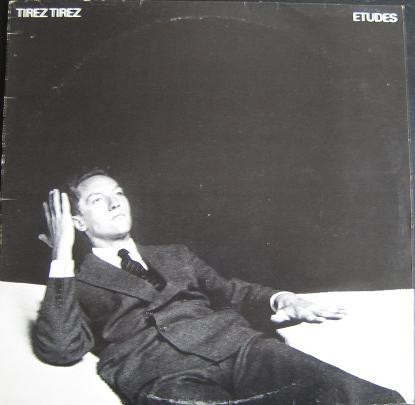
Tirez Tirez – Etudes, Aura, 1980, by Brian Griffin (design by Bill Smith)
Brian Griffin: ‘This photograph was taken in my studio/bedroom at Elsynge Road in Wandsworth [south London] using my bed. The model is Martin Cropper, who I used in my work at the time. It was originally taken for my book Brian Griffin Copyright 1978 and later purchased for the cover by Aaron Sixx of Aura records for Tirez Tirez’.
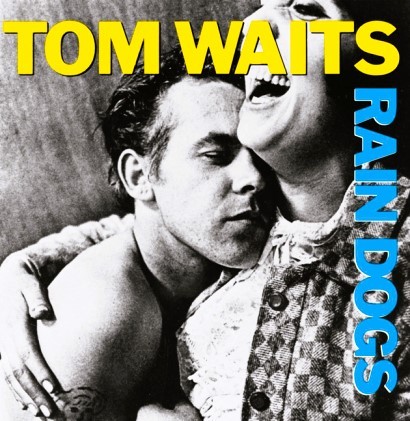
Tom Waits – Rain Dogs, Island Records, 1985, by Anders Petersen
Rain Dogs is the ninth studio album by American singer-songwriter Tom Waits, released in September 1985 on Island Records. A loose concept album about "the urban dispossessed" of New York City, Rain Dogs is generally considered the middle album of a trilogy that includes Swordfishtrombones and Franks Wild Years.
The album, which features guitarists Keith Richards and Marc Ribot, is noted for its broad spectrum of musical styles and genres, described by Arion Berger as merging "outsider influences – socialist decadence by way of Kurt Weill, pre-rock integrity from old dirty blues, the elegiac melancholy of New Orleans funeral brass – into a singularly idiosyncratic American style."
The album peaked at number 29 on the UK charts and number 188 on the US Billboard Top 200. Rod Stewart had success with his cover of "Downtown Train", later included on some editions of his 1991 album Vagabond Heart. In 1989, it was ranked number 21 on the Rolling Stone list of the "100 greatest albums of the 1980s." In 2012, the album was ranked number 399 on the magazine's list of "The 500 Greatest Albums of All Time", and at number 357 in 2020.
Though it has been remarked that the man on the cover bears a striking resemblance to Waits, the photograph is actually one of a series taken by the Swedish photographer Anders Petersen at Café Lehmitz (a café near the Hamburg red-light boulevard Reeperbahn) in the late 1960s. The man and woman depicted on the cover are called Rose and Lilly.
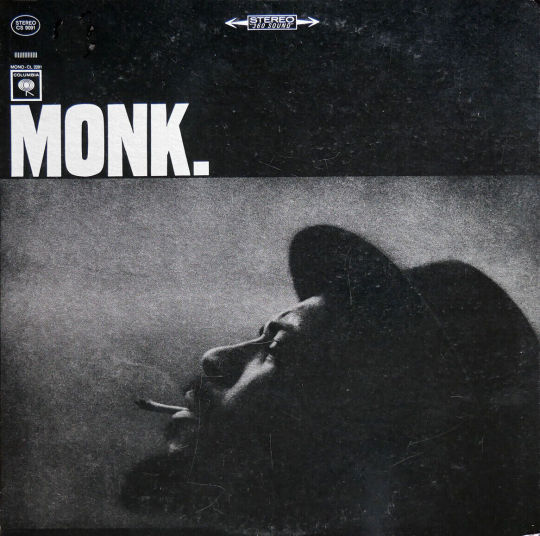
Thelonious Monk – Monk, Columbia, 1964, by W Eugene Smith
Monk. (1964) is the fourth studio album Thelonious Monk released on Columbia Records, and his seventh album overall for that label. It features two original compositions and several jazz standards.
The track "Pannonica" is a tribute to the jazz patron Pannonica de Koenigswarter. The track "Teo" is a tribute to the album's producer Teo Macero.
The album cover is a photo of Monk taken by W. Eugene Smith in 1959. Between 1957 and 1965, Monk and other prominent New York jazz musicians rehearsed at the photographer's home, nicknamed 'The Jazz Loft'.
Photographer and photojournalist W Eugene Smith demanded such perfection of his images that he destroyed most of his early work. He had a vast career and helped define photojournalism through his work at Life magazine, before joining Magnum Photos in 1955. He is remembered as a master both technically and in the darkroom. This photograph is titled Thelonious Monk Rehearsing in the Loft, 1959.
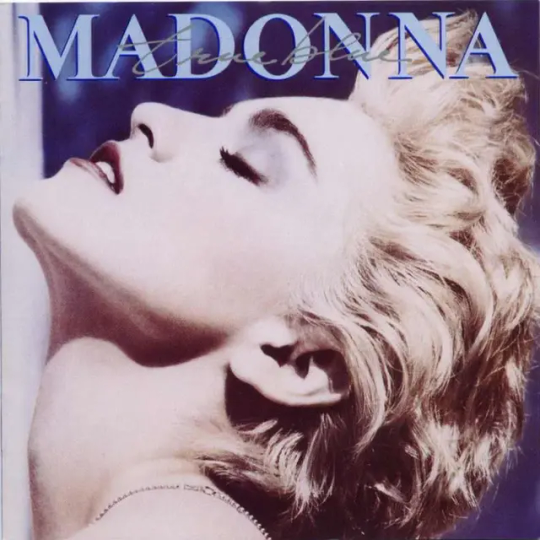
Madonna – True Blue, Sire/Warner, 1986, by Herb Ritts
The album cover was shot by photographer Herb Ritts. It shows Madonna in profile, with her head thrown back and eyes closed against a sky-blue background; her skin is bleached-out, and her hair platinum blonde. Jeri Heiden, who was working at the Warner Bros. art department, was given the task of editing the photos to adapt them into record covers. The final photo was selected by Madonna, Heiden and Jeff Ayeroff, creative director of Warner Bros. at that time. After the image was chosen, Heiden experimented with a variety of treatments of the original, which was shot in black and white, to go along with the album's title, and finally arrived at the final, blue toned, hand tinted version. The album's inner sleeve did not feature any photographs, and instead was dedicated to album credits and song lyrics, since Madonna wanted to be represented by her work rather than her image.
Lucy O'Brien described the cover as a "moment of Warholian pop art. A mixture of innocence [and] idealism […] Our first glimpse of Madonna as a classic icon". For J. Randy Taraborrelli, author of Madonna: An Intimate Biography, the artwork indicated how "[True Blue] was a vehicle of growth for [Madonna]"; the "washed out color photograph" cover was "understated", especially when compared to the "sexier poses" she had been associated with in the past. For Joe Lynch from Billboard, it is one of the greatest album covers of all time.
True Blue was released on June 30, 1986. In the United States and Canada, the cover did not include the singer's name. Heiden explained in an interview with Aperture magazine that the record company thought it would be "cool" to use a shrink wrap on American releases, so that when the public took it off, they'd be left with the photograph of Madonna. In Europe, Warner felt that the name was needed, as they did not want to risk messing with Madonna's popularity. The back sleeve and booklet feature the song titles in Heiden's own handwriting. About cropping the image for the cassette and vinyl releases, Heiden said: "I think the image became more interesting cropped into a square—and at that time we always started with the album cover configuration. It was like she was floating—her clothing was not visible. She took on the appearance of a marble statue—Goddess like. In the vertical cropping you see her leather jacket and the wall, and it becomes more typical, editorial, earthly". On May 22, 2001, Warner Bros. released a remastered edition of the album with two additional remixes of "True Blue" and "La Isla Bonita". Twenty years later, a 35th anniversary edition was released; it includes additional remixes, dub and instrumental versions. It was reissued on crystal clear vinyl on November 8, 2019.
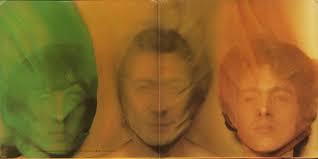
The Rolling Stones – Goats Heads Soup, The Rolling Stones Records, 1973, by David Bailey (design by Ray Lawrence)
Goats Head Soup is the eleventh studio album by the English rock band the Rolling Stones, released on 31 August 1973 by Rolling Stones Records. Like its predecessor Exile on Main St., the band composed and recorded much of it outside of the United Kingdom due to their status as tax exiles. Goats Head Soup was recorded in Jamaica, the United States and the United Kingdom. The album contains 10 tracks, including the lead single "Angie" which went to number one as a single in the US and the top five in the UK.
The album cover was designed by Ray Lawrence and photographed by David Bailey, a friend of Jagger's who had worked with the Rolling Stones since 1964. The portrait of Jagger on the front cover was approximately life size in the original 12-inch LP format. Jagger was reluctant to be shot enveloped by a pink chiffon veil, which Bailey said was meant to look like "Katharine Hepburn in The African Queen". The album's gatefold has Taylor, Wyman and Watts wrapped in a similar fabric, and Richards on the back. The album's original rejected cover art featured the entire band as centaurs and an image of goat's head soup, a Jamaican dish made from a goat's body parts, such as the head, feet and testicles.
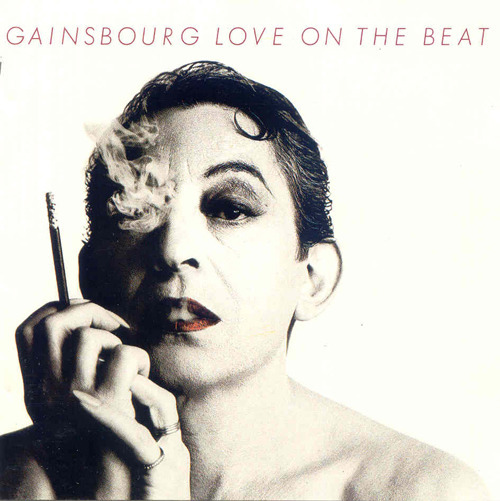
Serge Gainsbourg – Love on the Beat, Philips, 1984, by William Klein
Love on the Beat is the fifteenth studio album by French singer and songwriter Serge Gainsbourg. On this album, Gainsbourg used American musicians to achieve a funk-heavy rock sound. The album was controversial due to its very sexual lyrical content, with homosexuality and prostitution as the subject matters on many of the tracks. Perhaps the most controversial was "Lemon Incest", which was set to Frédéric Chopin's Étude No. 3 and sung as a duet with his then-13-year-old daughter Charlotte Gainsbourg.
French singer Serge Gainsbourg dressed in drag for the cover of Love on the Beat. Gainsbourg gave up alcohol for 12 days ahead of the shoot with legendary photographer William Klein to make himself beautiful.

Grace Jones – Island Life, Island Records, 1985, by Jean-Paul Goude (design by Greg Porto)
Island Life is the first greatest hits album by Jamaican singer and songwriter Grace Jones, released in December 1985, summing up the first nine years of her musical career. The album sits among Jones' best-selling works.
The cover picture is one of the most famous images of Grace Jones and was created by her then-partner Jean-Paul Goude. The impossibly graceful arabesque is actually a montage of separate images, following Goude's ideas on creating credible illusions with his cut-and-paint technique. The body position is "anatomically unlikely".
Jones assigned her then partner, Jean-Paul Goude, to create this cover image for Island Life. In what has become an iconic portrait, Goude compiled several separate snaps of Jones and constructed this lissom and elegant, if anatomically dubious, pose, all before Photoshop existed. ‘Unless you are extraordinarily supple, you cannot do this arabesque,’ Goude has said. ‘The main point is that Grace couldn’t do it, and that’s the basis of my entire work: creating a credible illusion’.
The picture was originally published in New York magazine in 1978 and subsequently used in the music video for Jones' hit single "La Vie en rose". It has been since described as "one of pop culture's most famous photographs". Also included in the album sleeve are other iconic images of Jones, among them the "twins" photograph, Grace Jones in a cage and wearing a "maternity" dress.
The cover picture was featured in Michael Ochs' 1996 book 1000 Record Covers and has been often imitated in works by other artists. The image was also referenced in Nicki Minaj's 2011 music video for "Stupid Hoe", with Minaj mimicking the pose.

Joe Jackson – Look Sharp!, A&M, 1979, by Brian Griffin (design by Michael Ross)
Look Sharp! is the debut album by Joe Jackson, released in January 1979. The album features one of Jackson's most well-known songs, "Is She Really Going Out with Him?", as well as the title track "Look Sharp", "Sunday Papers", "One More Time" and "Fools in Love".
The cover, featuring a pair of white shoes, ranked number 22 on Rolling Stone's list of the 100 greatest album covers of all time.
In 2000, it was voted number 865 in Colin Larkin's All Time Top 1000 Albums.
The photo used on the album's cover was shot by Brian Griffin on London's South Bank, near London Waterloo station. Upon arriving at the South Bank, Griffin noticed a shaft of light landing on the ground and asked Jackson to stand there: the whole process took no more than five minutes. According to Griffin, Jackson hated the record sleeve as it did not include his face, and vowed never to work with Griffin again. Nonetheless, the album artwork became one of the nominees for the 1980 Grammy Award for Best Recording Package.
Some observers didn't understand the tongue-in-cheek nature of Jackson's choice of title and cover art—an early reviewer in New Musical Express said they "suggest an obsession with style" and sniffed that Jackson sported "a pair of white side-lace Denson winklepickers that are, unfortunately, not nearly as cool as he evidently thinks they are". As time went on, journalists became more familiar with his youthful lack of interest in fashion, and The Face noted how most agreed with the general summation of him as a "sartorial disaster area".
Brian Griffin: ‘This was shot on London’s South Bank, which you could say was my open-air studio, as I did not have a studio then. I fell in love with the quality of light that pervaded there. It was the fastest album cover shoot that I ever did, maybe it took four minutes. I saw this patch of light making a pattern on the paving and said to Joe: “Stand there!”’

Diana Ross – Silk Electric, RCA, 1982, by Andy Warhol (photograph and design)
Silk Electric is the thirteenth studio album by American R&B singer Diana Ross, released on September 10, 1982, by RCA Records. It was Ross' second of six albums released by the label during the decade. It reached No. 27 on the US Billboard 200 (No. 5 R&B), No. 33 in the UK Albums Chart and the Top 20 in Sweden, Norway and the Netherlands. The album cover was designed by Andy Warhol.
The album contains Ross' US Top 10, Grammy-nominated single, "Muscles", which was written and produced by Michael Jackson. All other tracks were produced by Ross, including the US Top 40 follow-up single "So Close" featuring prominent background vocal arrangements by Luther Vandross.
The song "In Your Arms", written by Linda Creed and Michael Masser, was covered by Teddy Pendergrass and Whitney Houston as "Hold Me" the following year. The song "I Am Me" was co-written by Ross (and incorrectly listed as co-written by Cindy Birdsong instead of Janie Bradford on the Greatest Hits: The RCA Years compilation album). The album was certified Gold in the US and Silver in the UK.
The album was remastered and re-released on September 2, 2014 by Funky Town Grooves as an "Expanded Edition", with bonus material.

Rage Against the Machine – Rage Against the Machine, Epic, 1992, by Malcolm Browne
Rage Against the Machine is the debut studio album by American rock band Rage Against the Machine. It was released on November 6, 1992, by Epic Records, four days after the release of the album's first single, "Killing in the Name". The album was based largely on the band's first commercial demo tape of the same name, completed 11 months prior to the album's release. The tape contained earlier recordings of seven of the ten songs.
The cover features a crop of Malcolm Browne's famous photograph of the self-immolation of Thích Quảng Đức, a Vietnamese Buddhist monk, in Saigon in 1963. The monk was protesting against President Ngô Đình Diệm’s administration for oppressing the Buddhist religion. In 1963, Browne’s photography and coverage of the event earned him the World Press Photo of the Year award.
The songs on Rage Against the Machine all feature political messages. Activists such as Provisional IRA hunger striker Bobby Sands and Black Panther Party founder Huey P. Newton are listed in the "Thanks For Inspiration" section. Also thanked were Ian and Alec MacKaye.
The lyrics for each song were printed in the album booklet with the exception of those for "Killing in the Name", which were omitted; the booklet reads "2. KILLING IN THE NAME", skips the lyrics and continues with the next song.
The statement "no samples, keyboards or synthesizers used in the making of this record" can be found at the end of the sleeve notes. Similar statements were made in the band's subsequent albums. The band also refer to themselves as "Guilty Parties" for each album.
The album was a critical success upon release, with several critics noting the album's politically motivated agenda and praising frontman Zack de la Rocha's strong vocal delivery. Ranked number 24 on Rolling Stone's list of the "100 Greatest Metal Albums of All Time", the album peaked at number 1 on the US Billboard Heatseekers chart and number 45 on the US Billboard 200 and has gone on to achieve a triple platinum sales certification from the Recording Industry Association of America (RIAA) in the US. Multiple publications have ranked it as one of the best albums of the 1990s. In 2020, it was ranked 221 in Rolling Stone's updated list of the "500 Greatest Albums of All Time".

The Beatles – Abbey Road, Apple, 1969, by Iain Macmillan (design by John Kosh)
Abbey Road is the eleventh studio album by the English rock band the Beatles, released on 26 September 1969, by Apple Records. It is the last album the group recorded, although Let It Be (1970) was the last album completed before the band's break-up in April 1970. It was mostly recorded in April, July, and August 1969, and topped the record charts in both the United States and the United Kingdom. A double A-side single from the album, "Something" / "Come Together", was released in October, which also topped the charts in the US.
Apple Records creative director Kosh designed the album cover. It is the only original UK Beatles album sleeve to show neither the artist name nor the album title on its front cover, which was Kosh's idea, despite EMI saying the record would not sell without this information. He later explained that "we didn't need to write the band's name on the cover […] They were the most famous band in the world". The front cover was a photograph of the group walking on a zebra crossing, based on ideas that McCartney sketched, and taken on 8 August 1969 outside EMI Studios on Abbey Road. At 11:35 that morning, photographer Iain Macmillan was given only ten minutes to take the photo while he stood on a step-ladder and a policeman held up traffic behind the camera. Macmillan took six photographs, which McCartney examined with a magnifying glass before deciding which would be used on the album sleeve.
In the image selected by McCartney, the group walk across the street in single file from left to right, with Lennon leading, followed by Starr, McCartney and Harrison. McCartney is barefoot and out of step with the others. Except for Harrison, the group are wearing suits designed by Tommy Nutter. A white Volkswagen Beetle is to the left of the picture, parked next to the zebra crossing, which belonged to one of the people living in the block of flats across from the recording studio. After the album was released, the number plate (LMW 281F) was repeatedly stolen from the car. In 2004, news sources published a claim made by retired American salesman Paul Cole that he was the man standing on the pavement to the right of the picture.
Although Abbey Road was an instant commercial success, it received mixed reviews upon release. Some critics found its music inauthentic and criticised the production's artificial effects. By contrast, critics today view the album as one of the Beatles' best and one of the greatest albums of all time. George Harrison's two songs on the album, "Something" and "Here Comes the Sun", are considered among the best he wrote for the group. The album's cover, featuring the Beatles walking across the zebra crossing outside of Abbey Road Studios (then officially named EMI Studios), is one of the most famous and imitated of all time.

Graham Parker and the Rumour – The Parkerilla, Mercury, 1978, by Brian Griffin (design by Barney Bubbles)
The Parkerilla is a 1978 live double album by Graham Parker and The Rumour. It was recorded at Winter Gardens, Bournemouth, Manchester Opera House, Apollo Theatre, Oxford and The Palladium, New York City; and mixed at Rockfield Studios, Wales.
The album was recorded as a contractual obligation album as Parker had already signed with Arista and was preparing "Squeezing Out Sparks" for that label. The album was longer than a traditional record and Mercury elected to release it as a double album. The single "Hey Lord Don't Ask Me Questions" was a re-recording of a song from the first album (and slightly retitled) with the song occupying the fourth side.
The album met with a mixed reception from critics who were waiting for new material from Parker.
In 1991, Rolling Stone ranked The Parkerilla number 64 on its list of 100 greatest album covers. The cover photography was by Brian Griffin, with the artwork completed by Barney Bubbles.
Brian Griffin: ‘Dave Robinson of Stiff Records commissioned me for this. It was my first album cover and was shot on the South Bank in London next to the Hayward Gallery. The idea to make Graham Parker look like a gorilla was Dave’s, using prosthetics. This album was also my introduction to Barney Bubbles, who designed the cover’.

Led Zeppelin – Physical Grafitti, Swan Song, 1975, by Elliott Erwitt (design by AGI/Mike Doud/Peter Corriston)
Physical Graffiti is the sixth album by the English rock band Led Zeppelin. Released as a double album on 24 February 1975 in the United States and on 28 February 1975 in the United Kingdom, it was the group's first album to be released under their new label, Swan Song Records. The band wrote and recorded eight new songs for the album in early 1974 at Headley Grange, a country house in Hampshire, which gave them ample time to improvise arrangements and experiment with recording. The total playing time covered just under three sides of an LP, so they decided to expand it into a double album by including previously unreleased tracks from the sessions for the band's earlier albums Led Zeppelin III (1970), Led Zeppelin IV (1971) and Houses of the Holy (1973). The album covered a range of styles including hard rock, progressive rock, rock 'n' roll and folk. The album was then mixed over summer 1974 and planned for an end-of-year release; however, its release was delayed because the Peter Corriston-designed die-cut album cover proved difficult to manufacture.
The album was originally released with a die-cut sleeve design depicting a New York City tenement block, through whose windows various cultural icons could be interchangeably viewed. The album designer, Peter Corriston, was looking for a building that was symmetrical with interesting details, that was not obstructed by other objects and would fit the square album cover. He subsequently came up with the rest of the cover based on the idea of people moving in and out of the tenement, with various sleeves that could be placed under the main cover and filling the windows with various pieces of information.
The two five-storey buildings photographed for the album cover are located at 96 and 98 St. Mark's Place in New York City. The original photograph underwent a number of tweaks to arrive at the final image. The fourth floor of the building had to be cropped out to fit the square album cover format. (The front doorway and stoop at 96 St. Mark's Place is also the location used by the Rolling Stones for the music video promoting their single "Waiting on a Friend", from their 1981 album Tattoo You).
Eschewing the usual gatefold design in favour of a special die-cut cover, the original album jacket included four covers made up of two inners (for each disc), a middle insert cover and an outer cover. The middle insert cover is white and details all the album track listings and recording information. The outer cover has die-cut windows on the building, so when the middle cover is wrapped around the inner covers and slid into the outer cover, the title of the album is shown on the front cover, spelling out the name "Physical Graffiti". Images in the windows touched upon a set of American icons and a range of Hollywood ephemera. Pictures of W. C. Fields and Buzz Aldrin alternated with the snapshots of Led Zeppelin. Photographs of Lee Harvey Oswald, Marcel Duchamp and Pope Leo XIII are also featured. Per the liner notes, package concept and design was by AGI/Mike Doud (London) and Peter Corriston (New York). Photography was by Elliott Erwitt, B. P. Fallon, and Roy Harper. "Tinting Extraordinaire": Maurice Tate, and window illustration by Dave Heffernan. In 1976, the album was nominated for a Grammy Award in the category of best album package.
Physical Graffiti was commercially and critically successful upon its release and debuted at number one on album charts in the UK and number three in the United States. It was promoted by a successful U.S. tour and a five-night residency at Earl's Court, London. The album has been reissued on CD several times, including an expansive 40th anniversary edition in 2015. Physical Graffiti was later certified 16× platinum in the United States by the Recording Industry Association of America (RIAA) in 2006, signifying shipments of over eight million copies in the US.
Daily inspiration. Discover more photos at Just for Books…?
#just for books#Best Album Cover Shoots#Grace Jones#Prince#Boz Scaggs#Tirez Tirez#Tom Waits#Thelonious Monk#Madonna#The Rolling Stones#Serge Gainsbourg#Joe Jackson#Diana Ross#Rage Against the Machine#The Beatles#Graham Parker and the Rumour#Led Zeppelin
25 notes
·
View notes
Text
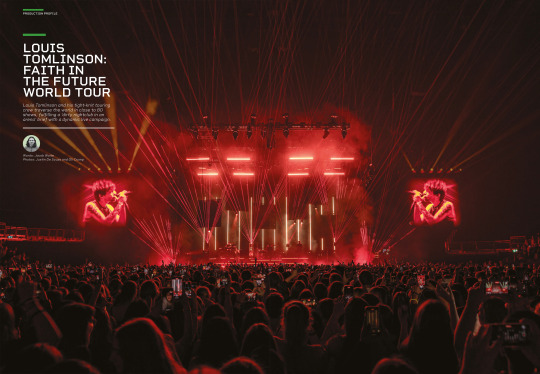
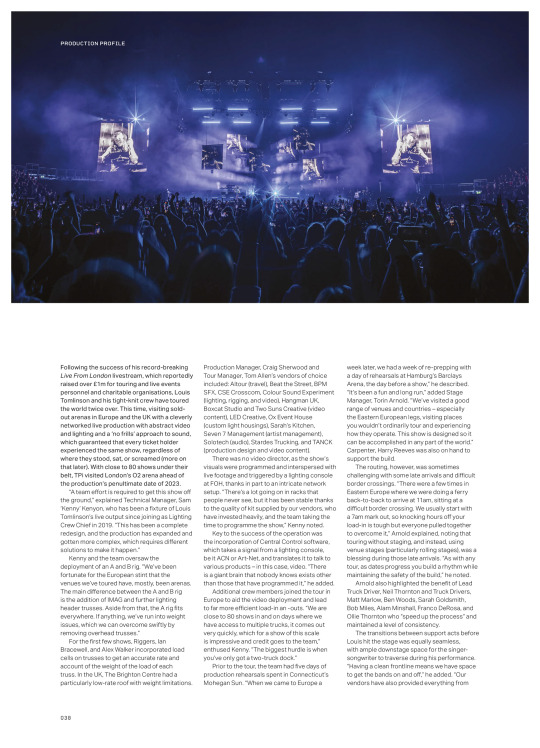

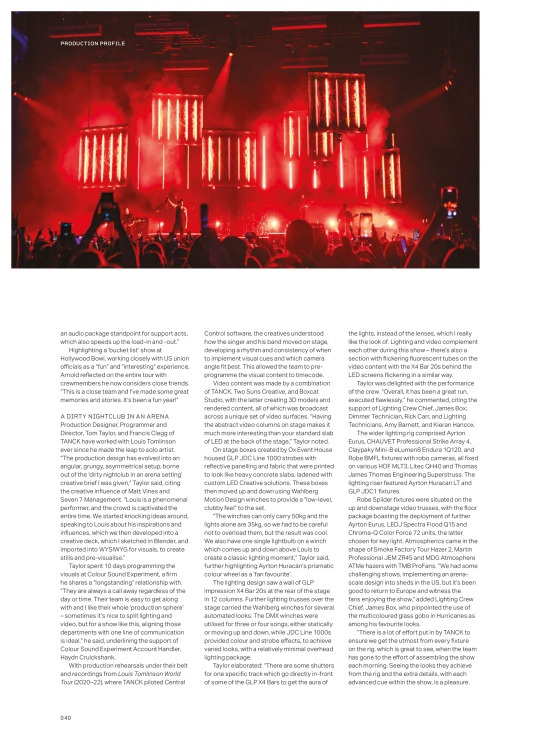

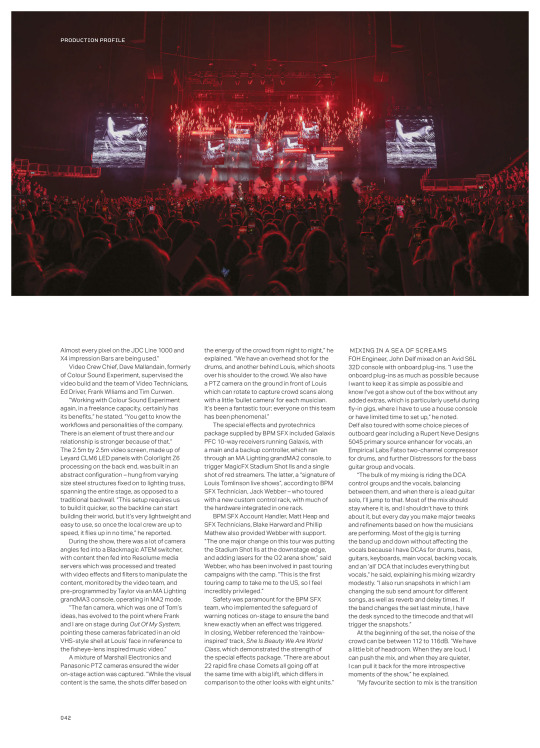
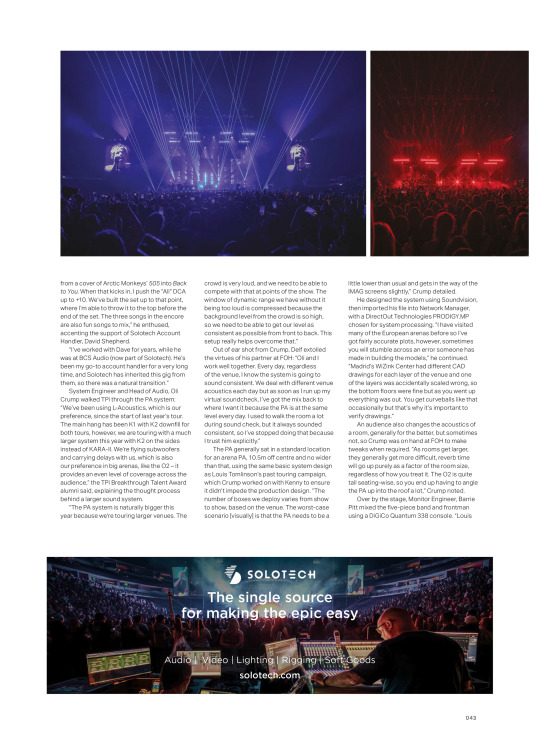
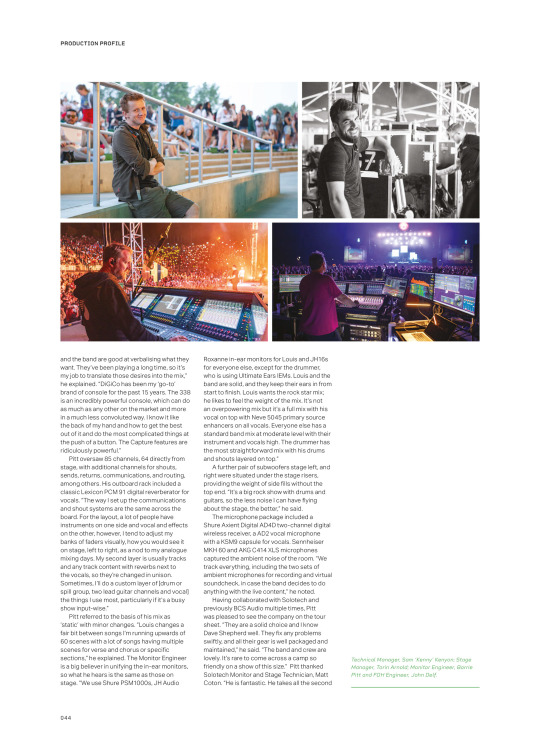

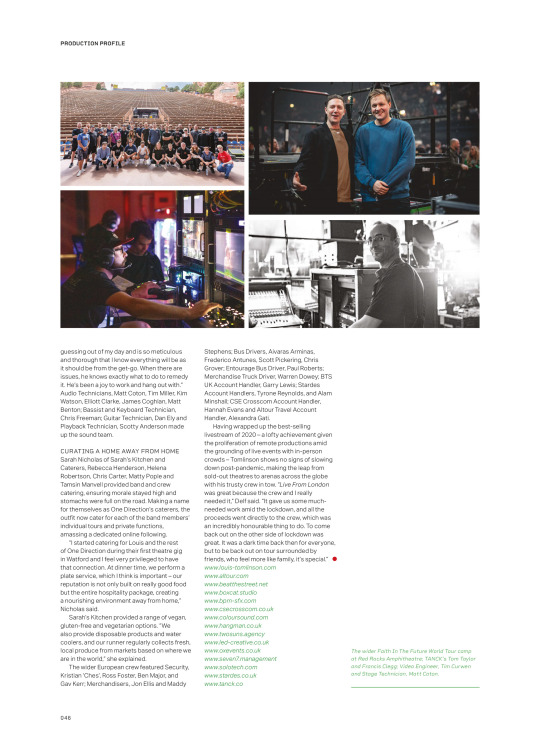
‘A dirty nightclub in an arena’ – behind Louis Tomlinson’s Faith In The Future World Tour
Louis Tomlinson and his tight-knit touring crew traverse the world in close to 80 shows, fulfilling a ‘dirty nightclub in an arena’ brief with a dynamic live campaign.
Production Profiles 5 January 2024
Following the success of his record-breaking Live From London livestream, which reportedly raised over £1m for touring and live events personnel and charitable organisations, Louis Tomlinson and his tight-knit crew have toured the world twice over. This time, visiting sold-out arenas in Europe and the UK with a cleverly networked live production with abstract video and lighting and a ‘no frills’ approach to sound, which guaranteed that every ticket holder experienced the same show, regardless of where they stood, sat, or screamed (more on that later). With close to 80 shows under their belt, TPi visited London’s O2 arena ahead of the production’s penultimate date of 2023.
Words: Jacob Waite Photos: Justin De Souza and Oli Crump
------
Following the success of his record-breaking Live From London livestream, which reportedly raised over £1m for touring and live events personnel and charitable organisations, Louis Tomlinson and his tight-knit crew have toured the world twice over. This time, visiting sold-out arenas in Europe and the UK with a cleverly networked live production with abstract video and lighting and a ‘no frills’ approach to sound, which guaranteed that every ticket holder experienced the same show, regardless of where they stood, sat, or screamed (more on that later). With close to 80 shows under their belt, TPi visited London’s O2 arena ahead of the production’s penultimate date of 2023.
“A team effort is required to get this show off the ground,” explained Technical Manager, Sam ‘Kenny’ Kenyon, who has been a fixture of Louis Tomlinson’s live output since joining as Lighting Crew Chief in 2019. “This has been a complete redesign, and the production has expanded and gotten more complex, which requires different solutions to make it happen.”
Kenny and the team oversaw the deployment of an A and B rig. “We’ve been fortunate for the European stint that the venues we’ve toured have, mostly, been arenas. The main difference between the A and B rig is the addition of IMAG and further lighting header trusses. Aside from that, the A rig fits everywhere. If anything, we’ve run into weight issues, which we can overcome swiftly by removing overhead trusses.”
For the first few shows, Riggers, Ian Bracewell, and Alex Walker incorporated load cells on trusses to get an accurate rate and account of the weight of the load of each truss. In the UK, The Brighton Centre had a particularly low-rate roof with weight limitations. Production Manager, Craig Sherwood and Tour Manager, Tom Allen’s vendors of choice included: Altour (travel), Beat the Street, BPM SFX, CSE Crosscom, Colour Sound Experiment (lighting, rigging, and video), Hangman UK, Boxcat Studio and Two Suns Creative (video content), LED Creative, Ox Event House (custom light housings), Sarah’s Kitchen, Seven 7 Management (artist management), Solotech (audio), Stardes Trucking, and TANCK (production design and video content).
There was no video director, as the show’s visuals were programmed and interspersed with live footage and triggered by a lighting console at FOH, thanks in part to an intricate network setup. “There’s a lot going on in racks that people never see, but it has been stable thanks to the quality of kit supplied by our vendors, who have invested heavily, and the team taking the time to programme the show,” Kenny noted.
Key to the success of the operation was the incorporation of Central Control software, which takes a signal from a lighting console, be it ACN or Art-Net, and translates it to talk to various products – in this case, video. “There is a giant brain that nobody knows exists other than those that have programmed it,” he added.
Additional crew members joined the tour in Europe to aid the video deployment and lead to far more efficient load-in an -outs. “We are close to 80 shows in and on days where we have access to multiple trucks, it comes out very quickly, which for a show of this scale is impressive and credit goes to the team,” enthused Kenny. “The biggest hurdle is when you’ve only got a two-truck dock.”
Prior to the tour, the team had five days of production rehearsals spent in Connecticut’s Mohegan Sun. “When we came to Europe a week later, we had a week of re-prepping with a day of rehearsals at Hamburg’s Barclays Arena, the day before a show,” he described. “It’s been a fun and long run,” added Stage Manager, Torin Arnold. “We’ve visited a good range of venues and countries – especially the Eastern European legs, visiting places you wouldn’t ordinarily tour and experiencing how they operate. This show is designed so it can be accomplished in any part of the world.” Carpenter, Harry Reeves was also on hand to support the build.
The routing, however, was sometimes challenging with some late arrivals and difficult border crossings. “There were a few times in Eastern Europe where we were doing a ferry back-to-back to arrive at 11am, sitting at a difficult border crossing. We usually start with a 7am mark out, so knocking hours off your load-in is tough but everyone pulled together to overcome it,” Arnold explained, noting that touring without staging, and instead, using venue stages (particularly rolling stages), was a blessing during those late arrivals. “As with any tour, as dates progress you build a rhythm while maintaining the safety of the build,” he noted.
Arnold also highlighted the benefit of Lead Truck Driver, Neil Thornton and Truck Drivers, Matt Marlow, Ben Woods, Sarah Goldsmith, Bob Miles, Alam Minshall, Franco DeRosa, and Ollie Thornton who “speed up the process” and maintained a level of consistency.
The transitions between support acts before Louis hit the stage was equally seamless, with ample downstage space for the singer-songwriter to traverse during his performance. “Having a clean frontline means we have space to get the bands on and off,” he added. “Our vendors have also provided everything from an audio package standpoint for support acts, which also speeds up the load-in and -out.”
Highlighting a ‘bucket list’ show at Hollywood Bowl, working closely with US union officials as a “fun” and “interesting” experience, Arnold reflected on the entire tour with crewmembers he now considers close friends. “This is a close team and I’ve made some great memories and stories. It’s been a fun year!”
A DIRTY NIGHTCLUB IN AN ARENA Production Designer, Programmer and Director, Tom Taylor, and Francis Clegg of TANCK have worked with Louis Tomlinson ever since he made the leap to solo artist. “The production design has evolved into an angular, grungy, asymmetrical setup, borne out of the ‘dirty nightclub in an arena setting’ creative brief I was given,” Taylor said, citing the creative influence of Matt Vines and Seven 7 Management. “Louis is a phenomenal performer, and the crowd is captivated the entire time. We started knocking ideas around, speaking to Louis about his inspirations and influences, which we then developed into a creative deck, which I sketched in Blender, and imported into WYSIWYG for visuals, to create stills and pre-visualise.”
Taylor spent 10 days programming the visuals at Colour Sound Experiment, a firm he shares a “longstanding” relationship with. “They are always a call away regardless of the day or time. Their team is easy to get along with and I like their whole ‘production sphere’ – sometimes it’s nice to split lighting and video, but for a show like this, aligning those departments with one line of communication is ideal,” he said, underlining the support of Colour Sound Experiment Account Handler, Haydn Cruickshank.
With production rehearsals under their belt and recordings from Louis Tomlinson World Tour (2020–22), where TANCK piloted Central Control software, the creatives understood how the singer and his band moved on stage, developing a rhythm and consistency of when to implement visual cues and which camera angle fit best. This allowed the team to pre-programme the visual content to timecode.
Video content was made by a combination of TANCK, Two Suns Creative, and Boxcat Studio, with the latter creating 3D models and rendered content, all of which was broadcast across a unique set of video surfaces. “Having the abstract video columns on stage makes it much more interesting than your standard slab of LED at the back of the stage,” Taylor noted.
On stage boxes created by Ox Event House housed GLP JDC Line 1000 strobes with reflective panelling and fabric that were printed to look like heavy concrete slabs, ladened with custom LED Creative solutions. These boxes then moved up and down using Wahlberg Motion Design winches to provide a “low-level, clubby feel” to the set.
“The winches can only carry 50kg and the lights alone are 35kg, so we had to be careful not to overload them, but the result was cool. We also have one single lightbulb on a winch which comes up and down above Louis to create a classic lighting moment,” Taylor said, further highlighting Ayrton Huracán’s prismatic colour wheel as a ‘fan favourite’.
The lighting design saw a wall of GLP impression X4 Bar 20s at the rear of the stage in 12 columns. Further lighting trusses over the stage carried the Wahlberg winches for several automated looks. The DMX winches were utilised for three or four songs, either statically or moving up and down, while JDC Line 1000s provided colour and strobe effects, to achieve varied looks, with a relatively minimal overhead lighting package.
Taylor elaborated: “There are some shutters for one specific track which go directly in-front of some of the GLP X4 Bars to get the aura of the lights, instead of the lenses, which I really like the look of. Lighting and video complement each other during this show – there’s also a section with flickering fluorescent tubes on the video content with the X4 Bar 20s behind the LED screens flickering in a similar way.
Taylor was delighted with the performance of the crew. “Overall, it has been a great run, executed flawlessly,” he commented, citing the support of Lighting Crew Chief, James Box; Dimmer Technician, Rick Carr, and Lighting Technicians, Amy Barnett, and Kieran Hancox.
The wider lighting rig comprised Ayrton Eurus, CHAUVET Professional Strike Array 4, Claypaky Mini-B eLumen8 Endura 1Q120, and Robe BMFL fixtures with robo cameras, all fixed on various HOF MLT3, Litec QH40 and Thomas James Thomas Engineering Superstruss. The lighting riser featured Ayrton Huracan LT and GLP JDC1 fixtures.
Robe Spiider fixtures were situated on the up and downstage video trusses, with the floor package boasting the deployment of further Ayrton Eurus, LEDJ Spectra Flood Q15 and Chroma-Q Color Force 72 units, the latter chosen for key light. Atmospherics came in the shape of Smoke Factory Tour Hazer 2, Martin Professional JEM ZR45 and MDG Atmosphere ATMe hazers with TMB ProFans. “We had some challenging shows, implementing an arena-scale design into sheds in the US, but it’s been good to return to Europe and witness the fans enjoying the show,” added Lighting Crew Chief, James Box, who pinpointed the use of the multicoloured glass gobo in Hurricanes as among his favourite looks.
“There is a lot of effort put in by TANCK to ensure we get the utmost from every fixture on the rig, which is great to see, when the team has gone to the effort of assembling the show each morning. Seeing the looks they achieve from the rig and the extra details, with each advanced cue within the show, is a pleasure.
Almost every pixel on the JDC Line 1000 and X4 impression Bars are being used.”
Video Crew Chief, Dave Mallandain, formerly of Colour Sound Experiment, supervised the video build and the team of Video Technicians, Ed Driver, Frank Wlliams and Tim Curwen.
“Working with Colour Sound Experiment again, in a freelance capacity, certainly has its benefits,” he stated. “You get to know the workflows and personalities of the company. There is an element of trust there and our relationship is stronger because of that.” The 2.5m by 2.5m video screen, made up of Leyard CLM6 LED panels with Colorlight Z6 processing on the back end, was built in an abstract configuration – hung from varying size steel structures fixed on to lighting truss, spanning the entire stage, as opposed to a traditional backwall. “This setup requires us to build it quicker, so the backline can start building their world, but it’s very lightweight and easy to use, so once the local crew are up to speed, it flies up in no time,” he reported.
During the show, there was a lot of camera angles fed into a Blackmagic ATEM switcher, with content then fed into Resolume media servers which was processed and treated with video effects and filters to manipulate the content, monitored by the video team, and pre-programmed by Taylor via an MA Lighting grandMA3 console, operating in MA2 mode.
“The fan camera, which was one of Tom’s ideas, has evolved to the point where Frank and I are on stage during Out Of My System, pointing these cameras fabricated in an old VHS-style shell at Louis’ face in reference to the fisheye-lens inspired music video.”
A mixture of Marshall Electronics and Panasonic PTZ cameras ensured the wider on-stage action was captured. “While the visual content is the same, the shots differ based on the energy of the crowd from night to night,” he explained. “We have an overhead shot for the drums, and another behind Louis, which shoots over his shoulder to the crowd. We also have a PTZ camera on the ground in front of Louis which can rotate to capture crowd scans along with a little ‘bullet camera’ for each musician. It’s been a fantastic tour; everyone on this team has been phenomenal.”
The special effects and pyrotechnics package supplied by BPM SFX included Galaxis PFC 10-way receivers running Galaxis, with a main and a backup controller, which ran through an MA Lighting grandMA2 console, to trigger MagicFX Stadium Shot IIs and a single shot of red streamers. The latter, a “signature of Louis Tomlinson live shows”, according to BPM SFX Technician, Jack Webber – who toured with a new custom control rack, with much of the hardware integrated in one rack.
BPM SFX Account Handler, Matt Heap and SFX Technicians, Blake Harward and Phillip Mathew also provided Webber with support. “The one major change on this tour was putting the Stadium Shot IIs at the downstage edge, and adding lasers for the O2 arena show,” said Webber, who has been involved in past touring campaigns with the camp. “This is the first touring camp to take me to the US, so I feel incredibly privileged.”
Safety was paramount for the BPM SFX team, who implemented the safeguard of warning notices on-stage to ensure the band knew exactly when an effect was triggered. In closing, Webber referenced the ‘rainbow-inspired’ track, She Is Beauty We Are World Class, which demonstrated the strength of the special effects package. “There are about 22 rapid fire chase Comets all going off at the same time with a big lift, which differs in comparison to the other looks with eight units.”
MIXING IN A SEA OF SCREAMS FOH Engineer, John Delf mixed on an Avid S6L 32D console with onboard plug-ins. “I use the onboard plug-ins as much as possible because I want to keep it as simple as possible and know I’ve got a show out of the box without any added extras, which is particularly useful during fly-in gigs, where I have to use a house console or have limited time to set up,” he noted. Delf also toured with some choice pieces of outboard gear including a Rupert Neve Designs 5045 primary source enhancer for vocals, an Empirical Labs Fatso two-channel compressor for drums, and further Distressors for the bass guitar group and vocals.
“The bulk of my mixing is riding the DCA control groups and the vocals, balancing between them, and when there is a lead guitar solo, I’ll jump to that. Most of the mix should stay where it is, and I shouldn’t have to think about it, but every day you make major tweaks and refinements based on how the musicians are performing. Most of the gig is turning the band up and down without affecting the vocals because I have DCAs for drums, bass, guitars, keyboards, main vocal, backing vocals, and an ‘all’ DCA that includes everything but vocals,” he said, explaining his mixing wizardry modestly. “I also run snapshots in which I am changing the sub send amount for different songs, as well as reverb and delay times. If the band changes the set last minute, I have the desk synced to the timecode and that will trigger the snapshots.”
At the beginning of the set, the noise of the crowd can be between 112 to 116dB. “We have a little bit of headroom. When they are loud, I can push the mix, and when they are quieter, I can pull it back for the more introspective moments of the show,” he explained.
“My favourite section to mix is the transition from a cover of Arctic Monkeys’ 505 into Back to You. When that kicks in, I push the ��All” DCA up to +10. We’ve built the set up to that point, where I’m able to throw it to the top before the end of the set. The three songs in the encore are also fun songs to mix,” he enthused, accenting the support of Solotech Account Handler, David Shepherd.
“I’ve worked with Dave for years, while he was at BCS Audio (now part of Solotech). He’s been my go-to account handler for a very long time, and Solotech has inherited this gig from them, so there was a natural transition.”
System Engineer and Head of Audio, Oli Crump walked TPi through the PA system: “We’ve been using L-Acoustics, which is our preference, since the start of last year’s tour. The main hang has been K1 with K2 downfill for both tours, however, we are touring with a much larger system this year with K2 on the sides instead of KARA-II. We’re flying subwoofers and carrying delays with us, which is also our preference in big arenas, like the O2 – it provides an even level of coverage across the audience,” the TPi Breakthrough Talent Award alumni said, explaining the thought process behind a larger sound system.
“The PA system is naturally bigger this year because we’re touring larger venues. The crowd is very loud, and we need to be able to compete with that at points of the show. The window of dynamic range we have without it being too loud is compressed because the background level from the crowd is so high, so we need to be able to get our level as consistent as possible from front to back. This setup really helps overcome that.”
Out of ear shot from Crump, Delf extolled the virtues of his partner at FOH: “Oli and I work well together. Every day, regardless of the venue, I know the system is going to sound consistent. We deal with different venue acoustics each day but as soon as I run up my virtual soundcheck, I’ve got the mix back to where I want it because the PA is at the same level every day. I used to walk the room a lot during sound check, but it always sounded consistent, so I’ve stopped doing that because I trust him explicitly.”
The PA generally sat in a standard location for an arena PA, 10.5m off centre and no wider than that, using the same basic system design as Louis Tomlinson’s past touring campaign, which Crump worked on with Kenny to ensure it didn’t impede the production design. “The number of boxes we deploy varies from show to show, based on the venue. The worst-case scenario [visually] is that the PA needs to be a little lower than usual and gets in the way of the IMAG screens slightly,” Crump detailed.
He designed the system using Soundvision, then imported his file into Network Manager, with a DirectOut Technologies PRODIGY.MP chosen for system processing. “I have visited many of the European arenas before so I’ve got fairly accurate plots, however, sometimes you will stumble across an error someone has made in building the models,” he continued. “Madrid’s WiZink Center had different CAD drawings for each layer of the venue and one of the layers was accidentally scaled wrong, so the bottom floors were fine but as you went up everything was out. You get curveballs like that occasionally but that’s why it’s important to verify drawings.”
An audience also changes the acoustics of a room, generally for the better, but sometimes not, so Crump was on hand at FOH to make tweaks when required. “As rooms get larger, they generally get more difficult, reverb time will go up purely as a factor of the room size, regardless of how you treat it. The O2 is quite tall seating-wise, so you end up having to angle the PA up into the roof a lot,” Crump noted.
Over by the stage, Monitor Engineer, Barrie Pitt mixed the five-piece band and frontman using a DiGiCo Quantum 338 console. “Louis and the band are good at verbalising what they want. They’ve been playing a long time, so it’s my job to translate those desires into the mix,” he explained. “DiGiCo has been my ‘go-to’ brand of console for the past 15 years. The 338 is an incredibly powerful console, which can do as much as any other on the market and more in a much less convoluted way. I know it like the back of my hand and how to get the best out of it and do the most complicated things at the push of a button. The Capture features are ridiculously powerful.”
Pitt oversaw 85 channels, 64 directly from stage, with additional channels for shouts, sends, returns, communications, and routing, among others. His outboard rack included a classic Lexicon PCM 91 digital reverberator for vocals. “The way I set up the communications and shout systems are the same across the board. For the layout, a lot of people have instruments on one side and vocal and effects on the other, however, I tend to adjust my banks of faders visually, how you would see it on stage, left to right, as a nod to my analogue mixing days. My second layer is usually tracks and any track content with reverbs next to the vocals, so they’re changed in unison. Sometimes, I’ll do a custom layer of [drum or spill group, two lead guitar channels and vocal] the things I use most, particularly if it’s a busy show input-wise.”
Pitt referred to the basis of his mix as ‘static’ with minor changes. “Louis changes a fair bit between songs I’m running upwards of 60 scenes with a lot of songs having multiple scenes for verse and chorus or specific sections,” he explained. The Monitor Engineer is a big believer in unifying the in-ear monitors, so what he hears is the same as those on stage. “We use Shure PSM1000s, JH Audio Roxanne in-ear monitors for Louis and JH16s for everyone else, except for the drummer, who is using Ultimate Ears IEMs. Louis and the band are solid, and they keep their ears in from start to finish. Louis wants the rock star mix; he likes to feel the weight of the mix. It’s not an overpowering mix but it’s a full mix with his vocal on top with Neve 5045 primary source enhancers on all vocals. Everyone else has a standard band mix at moderate level with their instrument and vocals high. The drummer has the most straightforward mix with his drums and shouts layered on top.”
A further pair of subwoofers stage left, and right were situated under the stage risers, providing the weight of side fills without the top end. “It’s a big rock show with drums and guitars, so the less noise I can have flying about the stage, the better,” he said.
The microphone package included a Shure Axient Digital AD4D two-channel digital wireless receiver, a AD2 vocal microphone with a KSM9 capsule for vocals. Sennheiser MKH 60 and AKG C414 XLS microphones captured the ambient noise of the room. “We track everything, including the two sets of ambient microphones for recording and virtual soundcheck, in case the band decides to do anything with the live content,” he noted.
Having collaborated with Solotech and previously BCS Audio multiple times, Pitt was pleased to see the company on the tour sheet. “They are a solid choice and I know Dave Shepherd well. They fix any problems swiftly, and all their gear is well packaged and maintained,” he said. “The band and crew are lovely. It’s rare to come across a camp so friendly on a show of this size.” Pitt thanked Solotech Monitor and Stage Technician, Matt Coton. “He is fantastic. He takes all the second guessing out of my day and is so meticulous and thorough that I know everything will be as it should be from the get-go. When there are issues, he knows exactly what to do to remedy it. He’s been a joy to work and hang out with.”
Audio Technicians, Matt Coton, Tim Miller, Kim Watson, Elliott Clarke, James Coghlan, Matt Benton; Bassist and Keyboard Technician, Chris Freeman; Guitar Technician, Dan Ely and Playback Technician, Scotty Anderson made up the sound team.
CURATING A HOME AWAY FROM HOME Sarah Nicholas of Sarah’s Kitchen and Caterers, Rebecca Henderson, Helena Robertson, Chris Carter, Matty Pople and Tamsin Manvell provided band and crew catering, ensuring morale stayed high and stomachs were full on the road. Making a name for themselves as One Direction’s caterers, the outfit now cater for each of the band members’ individual tours and private functions, amassing a dedicated online following. “I started catering for Louis and the rest of One Direction during their first theatre gig in Watford and I feel very privileged to have that connection. At dinner time, we perform a plate service, which I think is important – our reputation is not only built on really good food but the entire hospitality package, creating a nourishing environment away from home,” Nicholas said.
Sarah’s Kitchen provided a range of vegan, gluten-free and vegetarian options. “We also provide disposable products and water coolers, and our runner regularly collects fresh, local produce from markets based on where we are in the world,” she explained.
The wider European crew featured Security, Kristian ‘Ches’, Ross Foster, Ben Major, and Gav Kerr; Merchandisers, Jon Ellis and Maddy Stephens; Bus Drivers, Aivaras Arminas, Frederico Antunes, Scott Pickering, Chris Grover; Entourage Bus Driver, Paul Roberts; Merchandise Truck Driver, Warren Dowey; BTS UK Account Handler, Garry Lewis; Stardes Account Handlers, Tyrone Reynolds, and Alam Minshall; CSE Crosscom Account Handler, Hannah Evans and Altour Travel Account Handler, Alexandra Gati.
Having wrapped up the best-selling livestream of 2020 – a lofty achievement given the proliferation of remote productions amid the grounding of live events with in-person crowds – Tomlinson shows no signs of slowing down post-pandemic, making the leap from sold-out theatres to arenas across the globe with his trusty crew in tow. “Live From London was great because the crew and I really needed it,” Delf said. “It gave us some much-needed work amid the lockdown, and all the proceeds went directly to the crew, which was an incredibly honourable thing to do. To come back out on the other side of lockdown was great. It was a dark time back then for everyone, but to be back out on tour surrounded by friends, who feel more like family, it’s special.”
-> read here on Issuu
#louis#fitf tour#fitfwt#lt crew#tpi magazine#05.01.24#article#touring#thank youu omglarryrabbit ;)#love getting to peek behind the scenes this is great
101 notes
·
View notes
Text
The end of Oasis: the truth
Guitar smashing and recriminations... The events and causes of the bust-up that ended with Noel Gallagher walking out
Pete Paphides
Friday September 04 2009, 1.01am BST, The Times
Like a Cassandra to his own Trojan war, it might just be that last year Liam Gallagher saw the events of the past few weeks advancing over the horizon and felt unmoved to avert them. If, as sources close to the band suggest, the rest of Oasis plan to continue beyond Noel Gallagher’s departure, then the Liam-penned final tune on last year’s Dig Out Your Soul will assume some prescience. “Who’s to say/You were right/And I was wrong?/Soldier on.” Would they dare to, though? What kind of an ego would it take to continue Oasis without their songwriter Noel Gallagher, the man who gave them Live Forever, Wonderwall and Supersonic?
There’s no shortage of anecdotal material to suggest that Liam has succumbed to many of the clich?s that surround the pampered rock frontman. Own dressing room? Check. Boutique clothing range? Check. Personal security guard? Check. From here, it would be natural to infer a gulf that has Noel and the rest of Oasis on one side and Liam — who has long since relinquished even the need to be present at soundchecks — on the other. And yet it’s worth noting that — in the wake of the fight that nixed their appearance at Friday’s Paris en Seine festival — Liam and his wife Nicole Appleton high-tailed it to Lake Como in Italy with the Oasis bassist Andy Bell and his girlfriend in tow. According to one insider: “People are scared of Liam. And if he wants to carry on the band, Andy and [guitarist] Gem Archer will probably go along with it.” In the statement released hours after the Paris altercation, Noel pronounced himself disappointed with the ��lack of support and understanding from my management and bandmates that left me with no other option than to seek pastures new”.
The history of brothers in bands — from the Bee Gees to the Kinks — is dotted with recriminations and subsequent reconciliations. Oasis have had their fair share, most seriously in Barcelona nine years ago, when Liam goaded his brother by casting doubt on the legitimacy of Noel’s daughter Anaïs. Wasn’t there every reason, then, to assume that these latest wounds would also heal? Their mother Peggy seems to think so. “They love each other,” she says. “They’ve had fights before and got over it.”
Mothers often know best, but mothers are also rarely able to view their children’s spats as, well, anything more than children’s spats. In the wake of Oasis’s no-show at the V Festival — attributed to Liam’s laryngitis — the singer had seemed similarly keen to play down rumours that the band’s future was in jeopardy. Bypassing the spellchecking software on his phone, he issued a reassuring tweet to his fans: “The voice may of disappeared, but I’m still here ... I’m gutted your gutted what can I say f*** all at the moment.”
Friends of the guitarist, however, were left with an altogether graver picture. Noel told friends that Oasis would never play a British show again, the implication being that if they could just see out their remaining European festival shows, he could walk away quietly. If Oasis had fulfilled the Paris obligation, they would have had just one more show left to play.
So what happened at Rock en Seine to tip Noel over the edge? Despite occupying the neighbouring dressing room, the New York band Vampire Weekend have kept their counsel, merely hinting at the weirdness of coming off stage following a triumphant set to encounter ugly scenes. The Scottish singer-songwriter Amy McDonald was less discreet: “Oasis cancelled again, with one minute to stage time! Liam smashed Noel’s guitar, huuuge fight!”
Speaking to The Times, a source close to Noel said: “The problems began even before Liam arrived in Paris. He travelled separately from the band, as he does these days, on Eurostar. By the time he got to the venue he was his usual confrontational self. He said things about Noel’s family and made pointed personal insinuations about Sara [MacDonald, Noel’s partner].” What we now also know is that the guitar smashing involved an acoustic guitar given to Liam by Appleton, to which Noel laid waste before walking away.
In any band of Oasis’s stature there are usually systems in place to stop the build-up of tensions. If pre-gig drinking has the potential to become an issue, management and the security staff employed by them can ensure that group members make it onstage in a state of relative sobriety. In the days when Liam Gallagher was merely the frontman with Oasis, such matters would have been dealt with by the group’s management company, Ignition. In 2009, however, things have ceased to be as simple. Accompanying Gallagher on Eurostar was Stevie Allen, Liam’s personal security guard and the business partner with whom the singer set up his clothing line Pretty Green. As anyone who has kept up with Liam’s Twitter updates this year will know, the singer’s enthusiasm for Pretty Green seems, at times, to have eclipsed his enthusiasm for his band.
Sources close to Noel say that he is furious at what he sees as Liam’s willingness to use the goodwill earned by Oasis’s music to sell clothes. The confusion between Liam’s band and brand was further heightened by the singer’s recent interview with NME, arranged through the PR he uses for Pretty Green. Parading various garments on his label, Liam confirmed that the pair were no longer on speaking terms, alleging: “It takes more than blood to be my brother.”
Others have questioned the wisdom of a band with Oasis’s fractious history committing to a ten-month world tour — not least because of issues around the recording of Dig Out Your Soul that were still not resolved before its release. After eight weeks of sessions at Abbey Road studios, Liam had yet to record a single vocal. Speaking to Q magazine, Noel revealed that Liam waited until mixing for the album commenced in LA before recording his vocals. Even then, halfway though the fortnight-long stay in LA, Liam fled to London, saying he had “some business to attend to”. This, it turns out, was his wedding to Appleton, to which none of his bandmates had been invited. As a result, Noel told Q, the band were forced to shelve two album tracks, including “an epic, Champagne Supernova song with backwards Are You Experienced-type rhythms” and a 50-piece choir. Anything but contrite, Liam tweeted: “A 50-piece choir on it ... more like 50 shit guitar solos on it.”
And that’s the way it’s been with the Gallaghers this year. “He’s constantly going on about how much soul he’s got,” Noel said. “I assume Bob Marley had soul ... I don’t see Bob Marley at the Rainbow [the scene of the famous Wailers concert in 1977] wailing about the colour of the napkins in his dressing room.”
Paul Rees, the editor of Q, remembers being struck by the way that, throughtout their interview, Noel kept bringing the subject around to his brother. “He seemed so tired,” Rees says. “People who have seen them on tour this year have noticed that he seems to be going through the motions.”
Beneath the weariness, however, is hurt. “He’s never seen my little lad [one year-old Donovan]. Just pictures,” Noel confided (a claim strenuously refuted by Liam). “If you were in the circle of people that we are in, you wouldn’t have him in the house if he spoke to you the way he speaks to me and my family.”
One bone of contention appears to be MacDonald herself, who Liam is said to have consistently sought to antagonise. “At the Brits in 2007 Liam snatched her glass of wine and allowed it to smash at her feet,” one insider alleges. And the source of the acrimony? “They move in different circles. Sara knows journalists and people in the media. He sees her as sleeping with the enemy. Liam seems to prefer celebrities. He’s friends with Gok Wan and Holly Willoughby. Noel, meanwhile, prefers the company of musicians.”
Rees echoes the sentiments: “Noel has always been keen to broaden his musical horizons — perhaps more than Oasis would allow at times.” The man who discovered Oasis, Alan McGee, reckons it’ll be less than five years before the brothers end up on the same stage together. Friends of Noel suggest that ten years is a more realistic assessment. But If Liam’s ego has spiralled out of control, Noel may want to stop and consider whether he inadvertently had a hand in the process. Seven years ago, when his younger brother brought his maiden songwriting effort Little James to the table, Noel encouraged him to write more. Now, with three creditable efforts on Dig Out Your Soul, it’s conceivable that Liam — who, lest we forget, started Oasis without his brother — feels bold enough to carry the burden of their reputation.
In a funny way, he may even have a point. In this divorce, Liam may come off surprisingly well — at least in monetary terms. It may not excite the critics, but an Oasis that functions as a travelling jukebox — Britpop’s first heritage act — may play in Liam’s favour. Hard to imagine? Go and see Oasis live and the beery mass you see bellowing the words to Wonderwall bear far greater resemblance to Liam than Noel. Will they mind if Oasis never record another note? Or do they just want to party like it’s 1995?
#2009#paris#the breakup#whole band#noel interview#noel on liam#others on nl#pretty green#liam tweets#dig out your soul#things#this has got to be somewhere on someone's blog but i checked a few places and couldn't find it#i didn't make it past the first paragraph before i realized whose camp put this one out#liam was the one traveling separately? oh really tell us more about that#a really fun detail is that the whole liam-smashing-the-wine-glass thing was what like hours after noel said he'd send liam a valentine
17 notes
·
View notes
Text
Ko-Fi prompt from KemiKitty:
id enjoy hearing about concerts and ticket money if you want
Referencing my “how does this make money/how does this lose money” in this post.
Whoo! I actually really enjoy talking about money flow like this. Digging into examples like this helps with understanding the interconnectedness of the economic systems we inhabit, and with why things cost What They Do.
Disclaimer: I have not worked in this industry. I just majored in business, watch a lot of documentaries/video essays, and like to break down business and economic topics. When I got to performances, I try to figure these things out as an observer (dinner theater from watching Lindsey Sterling before she got super famous, more Traditional concerts at Staller Performing Arts center, Broadway shows) and asking questions of tour guides when at places like the Vienna Opera House.
Our Example: A moderately popular performer, in an enclosed performance space with a stage, fixed seating, and food service.
Let us consider a performer of middling popularity. They go on tours, but only in the lower 48 states, not yet internationally. They do single nights at an independent venue, which has either dinner tables or rows of audience seating. Let's say... 350 seats, in a middle-sized city, with $30/ticket on average, with wiggle room depending on seating, VIP passes, and discounts (groupons, senior, military, annual passes, etc).
So, who is getting paid, and who is paying?
Money coming into the venue, tied directly to this one event:
Tickets The people who came to this concert are paying for the tickets. 350 seats, at an average of $30/ticket, that's about $10,500. Most of this money does not go to the venue, but may pass through it, or leave a cut with it. (Depends on the ticketing software; we're saying this is an independent venue, not part of the ticketmaster situation, so it's a maybe.)
Food and drink The venue sells snacks, possibly full meals, if it's a dinner-and-show location. It may sell alcohol. It almost definitely sells drinks, maybe has vending machines if nothing else. If attendees cannot bring their own food and drink, and don't want to leave the building so they don't miss the show, then the venue can mark up the food they sell.
Merchandise Dependent on the type of merch and the venue, this may be a flat fee, where the performer puts down a few hundred dollars up front to set up a table for after the concert, or it might be taking a small cut of whatever is sold that night. They might not charge anything, but we'll include it as a likely avenue of income. I can see some kinder venues waiving the fee for newer, up-and-coming artists, but generally you can assume that the venue will take a cut.
Money flowing out of the venue, tied directly to this one event:
The Performer and their team The ticket costs will go primarily to the performer, their backup dancers/singers/band, their manager, and whatever fund they have for things other than wages, like a tour bus rental fee, the label, the driver, the night's post-concert laundry costs, and so on. The chances of all that money going to a single performer is very low; you can generally assume they have backup, management, additional costs, and someone pulling the strings. There are exceptions, like unaffiliated stand-up comedians or other, genuinely solo acts, but for the type of event I'm outlining, these are all contributing factors. Performers may bring their own lighting/sound techs. The venue also might provide their own. For a larger venue, I'd assume both are involved; one who knows the concert's program, and one who knows the venue's setup.
Venue staff The ushers, lighting/sound technicians, the bar staff, the cook, the janitor, security, and anyone else who is working night-of is getting paid. We can equate their pay to the money coming in from specifically the food and drink sales, along with tips for the waitstaff in particular. By this, I mean that the correlation is such that, should sales fall, the corresponding cut in costs is employee labor (the bar staff and cooks), rather than the performers (whose costs are calculated in relation to the money they bring in relating to the ticket sales).
Food and Drink Raw ingredients for the food, wholesale costs for the liquor, napkins, single-use straws, and so on.
Printed Programs Someone has to print the little booklet that tells you who's performing tonight, who's performing for the next few months, and anything else you need to know. If it's a big-name cultural center, they may even include some interviews! But ink is expensive, and that's a lot of paper.
Money coming into the venue, not connected to the specific event:
Advertising Does the venue have posters around for local businesses? For insurance companies? For upcoming events? Someone is paying them for that. Does the venue intersperse the pre-show music over the speakers with the occasional ad spot? Someone is paying them for that. Does the venue have ads in the program booklet? Someone is paying them for that. For a really, really large venue, the kind with dozens or hundreds of employees and massive lighting/sound setups, they are liable to get most of their income from advertising.
Government Grants and Private Donations Depending on the venue, they may donations or grants. This is more likely to apply to a university/community performing arts center than a for-profit dinner theater, but it's a possibility.
Merchandise The venue may have merch that is unrelated to the performance of the night. A historic or novelty location is most likely to have success with this, selling beer glasses with their logo or a t-shirt with 'home of the [band from several decades ago]' printed across the front.
Money flowing out of the venue, not connected to the specific event:
Administrative/Overhead Employees Management, bookkeeping, legal, marketing, and so on.
Utilities Electricity, water, sewage, gas, telecomm, and so on.
Taxes, Licenses, Fees Sales tax, property tax, liquor license, etc.
Mortgage or lease The venue's business owner is not necessarily the one to own the property outright. They may pay rent to a property owner, or mortgage to the bank.
Maintenance - Building Codes Any large building is going to need plumbers, glass techs, electricians, roofers, and so on coming by with regularity. (This part, I actually do know; I used to do repairs dispatching, and you'd be amazed how frequently a big box store needs someone to come by about the toilets.)
Maintenance - Venue Codes There are certain things that an entertainment venue needs to do that other businesses... don't. Namely, fire safety. It's a huge deal. Staying up to code can be expensive, especially if you need to get your backstage/wing curtains chemically treated again, which can be anywhere from one to five years, or the next time someone spills water on it. (That's the main reason open containers of liquids aren't allowed backstage.)
Marketing Just like people pay the venue to advertise, the venue pays for others to advertise it. This could be in the local newspaper or online, but if a given performer isn't someone semi-famous on tour that has a following, then something else needs to draw in a regular paying crowd.
Miscellaneous Overhead There is a lot of overhead for any business of moderate size that has its costs spread out over the year. This includes hiring an accountant for tax season, purchasing uniforms for employees, replacing cutlery and plates and furniture as it wears out or gets lost, repainting the walls every few years, office supplies when the printer for the programs wears out, and so on.
Is this everything? Almost definitely not.
But, hopefully, I've untangled a few things that you may not have considered before.
Those tickets and drinks you bought cover a lot more than just the performer!
...unless it's through ticketmaster, in which case it's probably just the monopoly.
----
If you enjoyed this post, please support me on ko-fi! You can also prompt me for a business/econ topic of your choice here.
#business#budgeting#accounting#phoenix posts#ko fi#ko fi prompts#economics prompts#theater fires#are a big deal#this is what accountants do btw. they track all of this plus less concrete stuff like depreciating value or deferred costs
68 notes
·
View notes
Text
Want to start music as a career?🤔
Absolutely you can pursue a career in music, and there are numerous paths to gainful employment once you've honed your skills. Music, like any art form, offers a wide range of opportunities across different sectors, from performance to education, production, composition, and more. The key is to identify the area of music that most excites you and to build a skill set that aligns with it. Here are a few potential career avenues: Performance: You could perform as a solo artist, in a band, orchestra, or ensemble, whether in live settings, recording studios, or on tour. This could include classical, jazz, pop, or any genre that resonates with you. Music Education: Teaching music at various levels (from private lessons to school or university settings) is a stable and rewarding career. Many music teachers also supplement their income through performances or private tutoring. Music Production and Sound Engineering: Working behind the scenes, you could produce music, mix and master tracks, or work in sound engineering for film, television, or live events. The digital age has opened up even more opportunities in music production, where many people work remotely or as freelancers. Composition and Songwriting: If you have a flair for creating original music, composing for films, video games, commercials, or even writing songs for other artists is a viable career. Composers often have multiple income streams from licensing and royalties. Music Therapy: This is an emerging field where you can use music to support mental health, rehabilitation, and emotional well-being. It’s a rewarding way to blend music with a desire to help others. Music Business and Management: If you're interested in the industry side, you could manage artists, work in music marketing, music publishing, or help run record labels or music venues.
Session Musician or Producer: Many musicians find work as session artists, contributing to recording projects for other musicians or film soundtracks. Music Technology: With the rise of music software and apps, there are growing opportunities in developing new tools for musicians, working in audio programming, or creating virtual instruments. While a career in music may not always follow a traditional 9-to-5 path, it can definitely be financially sustainable and creatively fulfilling. Success often comes with dedication, networking, a strong portfolio, and an entrepreneurial mindset. The music industry is diverse, and many musicians build hybrid careers—performing, teaching, composing, and producing at the same time. In short, yes, you can absolutely make a living in music, but it often requires passion, persistence, and versatility. You may also note that music not only provides financial stability but also provides peace of mind and comfort that is the most important requirement in one’s life.
read more
2 notes
·
View notes
Text
India's Best Banquet Management Software | Wedding Venue Software
Optimize Banquet Management with House of Banquet – India's best Banquet Management Software. Elevate weddings seamlessly with our advanced Wedding Venue Software
1 note
·
View note
Text
Contact Us| Conference Management and Corporate Event Transportation TripKartz
Elevate Corporate Transportation with TripKartz — Where Business Meets Comfort!
Navigate the world of corporate travel seamlessly with TripKartz’s top-tier transportation services. Experience unparalleled efficiency and luxury for your business journeys. 🌟👔
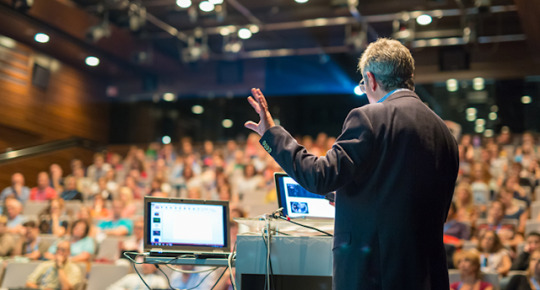
🌟 Key Services:
Executive Transfers: Travel in style with our fleet of executive cars for seamless airport transfers and corporate commuting.
Group Travel Solutions: From team-building outings to corporate events, our luxury coaches are designed for group comfort and convenience.
Event Logistics: Trust TripKartz to manage transportation logistics for corporate events, ensuring smooth coordination and timely arrivals.
Customized Packages: Tailored transportation solutions to align with the unique needs of your corporate agenda.
🔗 Learn more about our Corporate Transportation Services: TripKartz — Contact Us
✨ Why Choose TripKartz for Corporate Transportation? Experience the epitome of corporate travel excellence with TripKartz. Our commitment to reliability, efficiency, and client satisfaction sets us apart as your preferred business travel partner.
🚀 Connect with Us:
Website: TripKartz Corporate
Contact: Corporate Transportation Inquiry
Social: LinkedIn | Twitter
🌈 Let TripKartz be your driving force in corporate transportation. Elevate your business travels with comfort, style, and efficiency! 🌐🏢 #CorporateTransportation #BusinessTravel #TripKartzCorporate #BangaloreBusinessJourneys
Connect with TripKartz for cutting-edge conference management and seamless corporate transportation solutions. Elevate your events with our expertise. Contact us.
#business hotels#Keyword#corporate travel management companies in bangalore#travel management companies in bangalore#corporate meetings#Business events#events and meetings#"corporate travel agents#event venues#meeting venues#meetings and events planning#conference management#extended stay hotels#corporate meetings planning#business transportation#corporate events#corporate event management company#corporate travel management#corporate events and meetings#conference management software#corporate transportation#business car rentals#corporate travel agents#corporate hotels#conference venues
0 notes
Text
Surf Doha: Catch the Thrill with Venly

Get ready to ride the waves! Schedule your surfing experience today.
— in Doha, Qatar.
For more details visit venlyapp.com
#Doha event booking app#Venue booking app in Qatar#adventures booking app in Doha#event booking platform in qatar#event management software#adventures booking app#sports venue booking app in qatar#qatar#venue booking app
0 notes
Text
Can the presence of exalted planets in the 7th house indicate a successful and fulfilling marriage?
The 7th house in astrology is traditionally associated with marriage, partnerships, and committed relationships. When exalted planets are present in the 7th house, it can indeed suggest the potential for a successful and fulfilling marriage, but there are nuances to consider:
Nature of the Exalted Planets: The success and fulfillment of a marriage depend on the nature and condition of the exalted planets in the 7th house. For example, exalted Venus in the 7th house is generally considered auspicious for marriage, as Venus signifies love, harmony, and partnership. Similarly, exalted Jupiter in the 7th house can indicate a marriage blessed with wisdom, growth, and abundance. On the other hand, exalted Saturn may bring a sense of responsibility, stability, and longevity to the marriage, but it can also indicate challenges or delays.
Aspects and Influences: The aspects and influences on the exalted planets in the 7th house play a crucial role in determining the overall outcome of the marriage. Benefic aspects from other planets can enhance the positive qualities of the exalted planets, while malefic aspects may bring obstacles or difficulties. Additionally, the presence of malefic planets such as Mars or Saturn in the 7th house, even if exalted, can introduce challenges that need to be managed effectively.
Balance of Energies: A successful and fulfilling marriage often requires a balance of energies between partners. While exalted planets in the 7th house can indicate favorable conditions for marriage, it's essential to consider the balance of energies between the partners and the compatibility of their birth charts. Factors such as mutual respect, communication, shared values, and emotional compatibility play significant roles in sustaining a fulfilling marriage.
Individual Growth and Evolution: Marriage is a dynamic and evolving journey that involves personal growth and mutual understanding. Exalted planets in the 7th house may indicate opportunities for growth and evolution within the marriage, both individually and as a couple. However, it's essential for both partners to be committed to personal development and to work together to overcome challenges and deepen their connection over time.
Loving partnership. For this you can take help of Kundli Chakra 2022 Professional Software. You can get personalized information about the possible outcomes of marriage based on the positions and aspects of specific planets in your birth chart.
#astrology#astro observations#numerology#astro community#aries horoscope: star sign dates#birth chart#12th house#astrologer#cancer horoscope: star sign dates#8th house#aries weekly horoscope: what your star sign has in store for october 1 – 7#capricorn horoscope: star sign dates#capricorn weekly horoscope: what your star sign has in store for november 5 – 11#gemini horoscope: star sign dates#gemini weekly horoscope: what your star sign has in store for november 19 25#gemini weekly horoscope: what your star sign has in store for october 22 – 28#horoscope today#leo horoscope: star sign dates#horoscope#libra horoscope: star sign dates#andrew horowitz#horology
10 notes
·
View notes